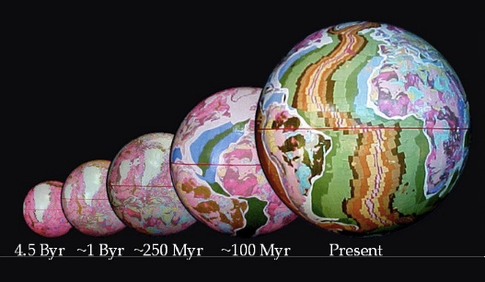How continental drift proves hollow planets (but not necessarily polar holes)
The oceanic crust covers 60% of the Earth surface. The oceanic crust has mostly formed in the past 120 million years, with the oldest dating back to the beginning of the mesozoic, and prior radial expansion formed the continental shelf. Since the surface area has increased with 60% to fit the oceanic crust, the radial increase needed for that can be calculated from A=4πr². The Earth without oceanic crust is 40% the surface area of Earth today, an increase with 1/0.4 = 2.5, and since the surface area is the square of the radius, the radial increase is sqrt(2.5). The increase in volume has been the cube of the radius, sqrt(2.5)³= 3.95285…, a 4-fold increase in volume.

Dr. James Maxlow’s models suggests the total radial increase is 4x. In this example only oceanic crust was accounted for, sqrt(2.5) = 1.58113… For the whole 4-fold radial increase there is a volume increase of 4³ = 64, so 64-fold increase in mass would be needed unless the Earth is hollow.
If there is no change in density, the sqrt(2.5)-fold increase in radius without a mass increase, has a 590 km thick shell. That can be derived by calculating the volume of sphere that would fit inside the hollow cavity of present day Earth when the volume of the Earth without oceanic crust is pushed to the surface. The radius of that sphere, cbrt(2.95285), calculated from 4/3πr³=4/3π(sqrt(2.5)n)³−4/3πn³, when subtracted from the radius of present day Earth, is the width of the shell, sqrt(2.5) — cbrt(2.95285) * 6371/sqrt(2.5) = 590 km.
Similarly, a 1.5x increase in radius, slightly smaller than sqrt(2.5), gives shell width 704 km, a 2-fold increase gives 277 km, and a 4-fold increase gives 33 km.
The “lore” around hollow Earth often says that the crust is 800 km thick, and also that it is cavernous. If the density has decreased with 2x, the volume occupied has doubled. Throwing that into the equation, the shell width is double that of the shell width with 1x density, and if the density has deceased by 3x, the shell width is 3x that at a density of 1x.
The equation to calculate the shell width when r = earth radius and at a given density becomes r – cbrt((4/3πr^3−4/3π(r/n)^3)3/4/π), divided with density.
With a 4-fold increase giving a shell width of 33 km at density 1, the shell would have to be 25x more caverns than matter, only 1/25 = 4%, for the shell to be 800 km thick, 33x25 = 825 km. The shell would have to be 96% caverns. In the same way, for a 2-fold expansion, shell has to be 66% caverns, 277x3 = 831 km. With sqrt(2.5) expansion, 30% caverns, and with sqrt(2) = 1.41x radial increase, 50% surface area increase and a shell width of 862 km at density 1, not cavernous at all.